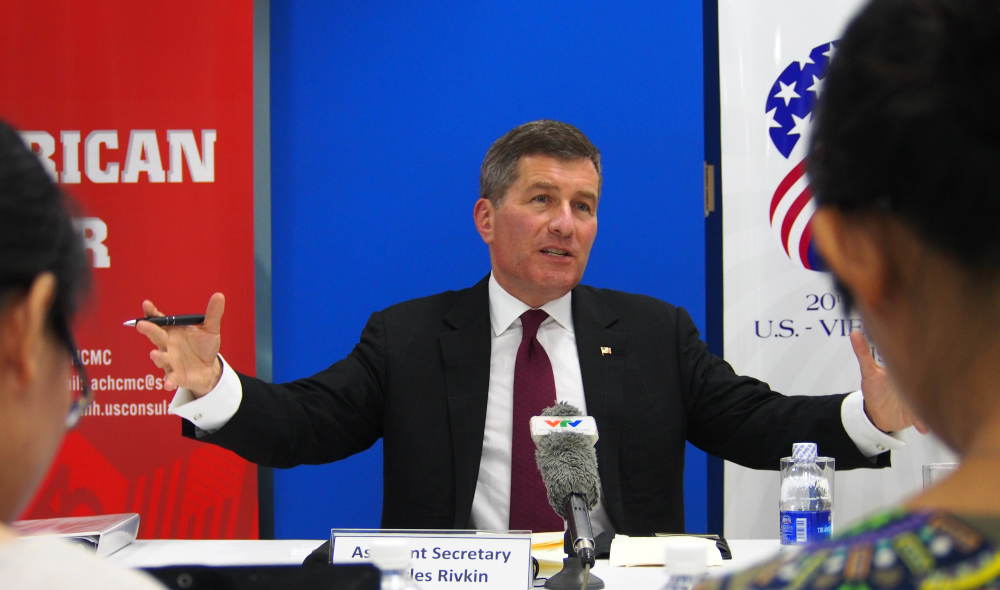The realization of the Trans-Pacific Partnership (TPP) trade agreement later this year will benefit all member countries, especially a small economy like Vietnam, said a senior U.S. official during his recent visit to Ho Chi Minh City.
>> An audio version of the story is available here
The U.S. government has prioritized the TPP as one of the most important objectives to achieve within the remaining term of President Barack Obama, Charles H. Rivkin, Assistant Secretary of State for Economic and Business Affairs, said at a press meeting at the American Center in the southern city last Friday.
The TPP is a proposed regional free trade agreement aimed at eliminating tariffs and lowering non-tariff barriers that is being negotiated by 12 countries throughout the Asia-Pacific region.
The countries include Australia, Brunei, Canada, Chile, Japan, Malaysia, Mexico, New Zealand, Peru, Singapore, the United States, and Vietnam, which collectively contribute almost half of global output and over 40 percent of world trade, according to the Office of the United States Trade Representative.
“I cannot give a time frame because I cannot speak for Congress, but there are positive developments and the trade promotion authority [TPA] is being discussed and debated now,” Rivkin said.
The TPA, also called the fast track negotiating authority for trade agreements, is the authority of the President of the United States to negotiate international agreements that Congress can vote for or against but cannot amend or filibuster.
The TPA was already adopted by the U.S. Senate last month, and is waiting to be cleared by Congress.
“The TPP will open an unprecedented channel of commerce and potential prosperity for the twelve nations, including America and Vietnam,” Rivkin said.
“The completion of the trade pact this year is the most important economic and strategic thing and most important action we can take not only for Vietnam but for the Asia-Pacific region.
“The TPP is a high-standard and ambitious treaty that opens new markets for our entrepreneurs, new choices for consumers, sets new standards for workers, including the air we breathe, and economic means that will build a positive architecture of security throughout the region.”
With the materialization of the TPP, Vietnam's GDP may increase more than 30 percent within 10 years after joining the agreement, Rivkin quoted research by the U.S.-based Peterson Institute for International Economics as saying.
Joining the TPP will not only enable Vietnam to integrate into global supply chains, but also allow the country to be ranked among the leading economies in the Asia-Pacific region, he said.
Trade between Vietnam and the U.S. was worth only US$450 million 20 years ago, but has since skyrocketed to $40 billion, up more than 100 times in two decades, the Assistant State Secretary said.
Therefore, trade between the two countries will surely grow rapidly if the trade pact is completed, he added.
One of the reasons the U.S. wants to promote the trade agreement, according to Rivkin, is ASEAN, of which Vietnam is a member, have more than 550 million consumers, a number which is projected to rise to 2.7 billion by 2030, six times bigger than the U.S. population.
ASEAN is short for Association of Southeast Asian Nations, including Malaysia, Indonesia, Thailand, the Philippines, Vietnam, Singapore, Laos, Cambodia, Myanmar, and Brunei.
Doubled benefits
In addition to trade benefits, Vietnam will also grow rapidly after joining the TPP thanks to more foreign investment inflow, Rivkin said.
Any businesses investing in a given market are keen on three things: transparency, predictability and the rule of law, which have already been specifically mentioned in the TPP.
“Therefore, with Vietnam’s commitments when participating in the TPP, the country will have to create an attractive environment for investors not only from America but also from around the world,” he said.
Furthermore, this agreement could create a strategic alliance so that member countries can be much closer, thus raising a wave of intra-bloc outflow investments, he added.
The TPP will also positively impact many industries in Vietnam and the U.S. with the removal of both tariff and non-tariff barriers, Rivkin said.
“Among the 12 countries in TPP negotiations, the United States is the largest single market in the world, with more than 28 million small and medium enterprises [SME]. In terms of numbers, SMEs account for 98 percent of total enterprises in the country,” he said.
However, small and medium enterprises produce only one percent of the total annual GDP, worth about US$19 trillion, of the U.S. and only one percent of them are exporting, he said.
The lifting of both tariff and non-tariff barriers will have a great positive impact on SMEs in the U.S., and a similar scenario will also take place in Vietnam.
SMEs are the backbone of any economy, so the TPP may facilitate SME sector growth and offer them the first opportunity to export goods to other countries, something that previously they could not do without the treaty, he added.
“During the meetings and contact with the American Chamber of Commerce in more than 30 cities worldwide when I served as U.S. Assistant Secretary of State for Economic and Business Affairs, I have not seen such excitement as I did when meeting with them in Hanoi and Ho Chi Minh City during my current visit,” he said.
“American businesses have been pouring capital into Vietnam, and want to invest more, partly due to the anticipation of the TPP, and the potential of the local market given its abundant, young and energetic workforce and the availability of many attractive investment opportunities here," he stressed.
Like us on Facebook or follow us on Twitter to get the latest news about Vietnam!




















































